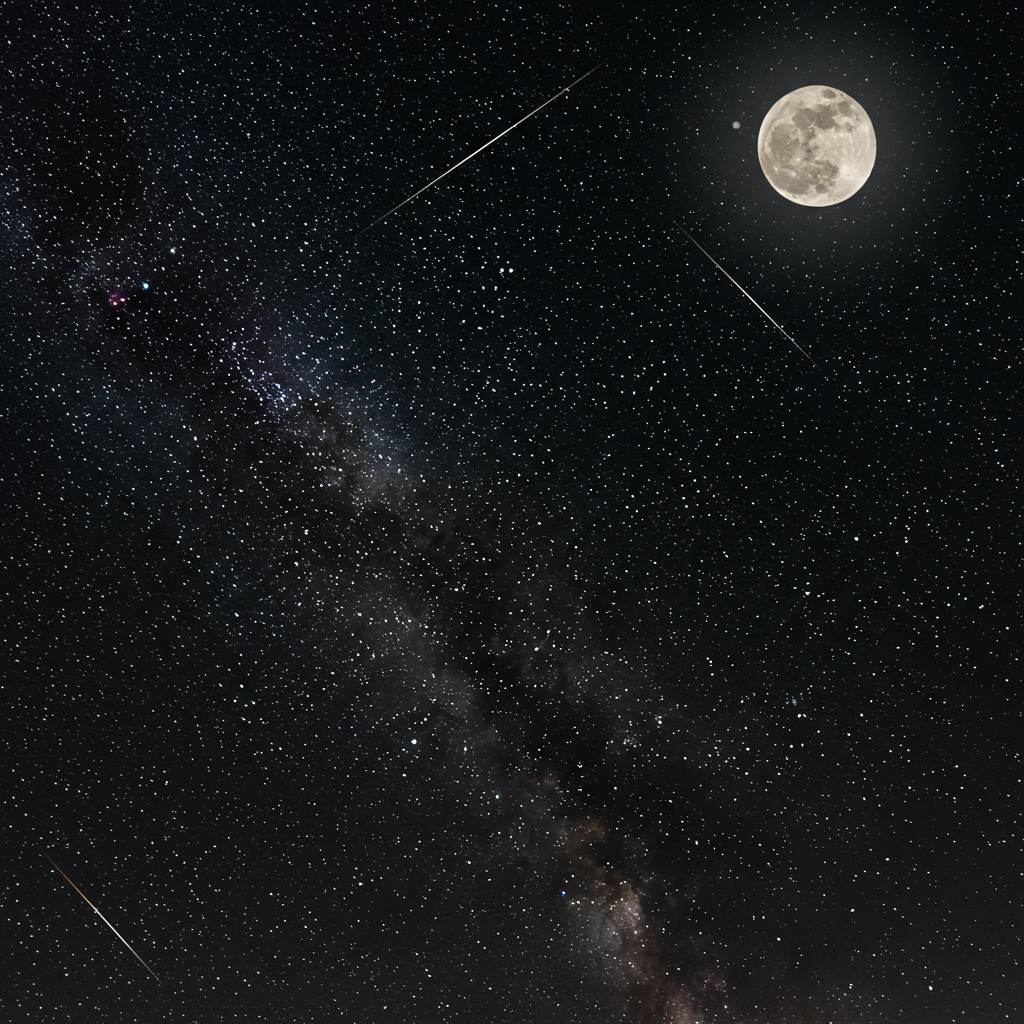August 2025 promises a spectacular show for skygazers. This guide highlights the dazzling array of celestial events, from the radiant Full Sturgeon Moon to the highly anticipated Perseid meteor shower and stunning planetary alignments. Prepare to witness some of the year’s most captivating cosmic displays.
The Glorious Full Sturgeon Moon
August begins with the Full Sturgeon Moon, a breathtaking lunar spectacle. This eighth full moon of 2025 peaks at 3:55 a.m. EDT on Friday, August 9. It will appear full and bright for several nights around this date.
The name “Sturgeon Moon” honors Native American and colonial traditions. It marks when large sturgeon fish were easily caught in North American waterways. Other names include Dry Moon (Catawba Nation), Ricing Moon, and Hot Moon, reflecting late summer. Unlike certain years, August 2025 features 12 full moons, so no rare “Blue Moon” will occur. A Blue Moon is either the second full moon in a month or the third in a season with four.
Planetary Spectacles: Conjunctions and Parades
August 2025 offers prime opportunities for planet spotting, with several breathtaking alignments.
Jupiter and Venus Embrace the Dawn
Days after the Sturgeon Moon, early risers can spot a celestial treat. On Tuesday, August 12, Jupiter and Venus will form a remarkable planetary conjunction. These two brightest planets appear incredibly close in the predawn sky, less than one degree apart. This creates a brilliant, unmissable sight.
Optimal viewing is expected after 4 a.m. EST, requiring a clear eastern horizon. No telescope is needed, but binoculars can enhance the view. A similar close alignment will still be visible the next morning for those who miss it.
The Grand August Planet Parade
Beyond the Jupiter-Venus pairing, August brings a broader “planet parade.” Mars shines brightly in the western evening sky after sunset. It appears as a red, unblinking ‘star’ near Spica.
The main planetary event unfolds in predawn hours. From August 10, Mercury joins Venus and Jupiter in the eastern sky, forming a naked-eye trio. Saturn will also be visible further south. With optical aids, Uranus and Neptune can expand this to a six-planet spectacle. This alignment lasts nearly all month. The waning crescent moon will also pass these planets, offering great photo chances around August 19-21.
Mars and the Late-Month Crescent Moon
Late in August, observe another charming lunar-planetary pairing. On the evening of August 26, a slender crescent moon appears alongside Mars in the western sky. The Farmer’s Almanac suggests 8:15 p.m. local time for ideal viewing.
Venus Meets the Beehive Cluster
To end the month, August 31 brings Venus and the Beehive Cluster (Praesepe). Venus shines brightly in the east-northeast sky. It will be accompanied by the open star cluster in Cancer. Venus is naked-eye visible, but binoculars enhance the Beehive Cluster view. This offers a subtle, beautiful treat for early risers.
The Annual Perseid Meteor Shower: A Challenging Peak
The Perseid meteor shower, one of the year’s most anticipated astronomical events, peaks August 11–13. Originating from Comet Swift-Tuttle’s debris, Perseids are known for intensity. Under ideal conditions, they can yield up to 100 meteors per hour. They also produce numerous bright fireballs, sometimes visible even through light pollution.
Navigating the Moonlight Challenge
August 2025 presents a significant Perseid viewing challenge: a bright waning gibbous moon. The moon will be over 90% full during peak nights, severely compromising visibility. Experts warn lunar interference could reduce activity by at least 75%. This means only the brightest meteors might be seen, perhaps 10-20 per hour instead of 60-100.
To maximize chances, view before midnight on peak nights when the moon is lower or less impactful. Alternatively, try August 15, when the moon has waned significantly, offering darker skies. The most impressive part of the Perseids display typically occurs later in the night, into the pre-dawn hours. Focus on the darkest sky areas, away from lunar glare.
Other Active Meteor Showers
Beyond the Perseids, August sees the winding down of the Delta Aquariids and Alpha Capricornids. While less prolific, they may offer sporadic shooting stars in the month’s first half.
Deep Sky Wonders and Dark Sky Opportunities
August offers prime conditions for observing distant galaxies and nebulae, beyond just the moon and planets.
The Majestic Milky Way
From August 16-26, absent bright moonlight creates optimal dark conditions for viewing the Milky Way. Our galaxy’s dense core will be prominently visible in the southern sky. Look for it stretching from the Summer Triangle constellation towards Scorpius and Sagittarius. International Dark Sky Places offer the most breathtaking views.
The Significance of the Black Moon
August 23 brings a “Black Moon,” the third new moon in a season with four. Though not visible, its importance is creating a completely moonless night. This lunar light absence is ideal for deep-sky observation and astrophotography. Distant stars, galaxies, and constellations will shine with maximum brilliance.
Spotting the Summer Triangle
The Summer Triangle, visible year-round, offers ideal August viewing. This celestial isosceles triangle forms from three bright stars: Deneb (in Cygnus), Vega (in Lyra), and Altair (in Aquila). Look for it in the eastern sky after sunset.
Essential Stargazing Tips for August 2025
To fully enjoy these incredible August 2025 celestial events, follow these practical tips:
Find Dark Skies: Get away from city light pollution. This is crucial for meteors and the Milky Way.
Check the Weather: Clear skies are essential for any viewing.
Allow Eyes to Adjust: Give your eyes 15-20 minutes to adapt to darkness. Avoid phone screens.
Dress Appropriately: Even warm nights can get cool. Bring layers or a blanket.
Patience is Key: Celestial events unfold gradually; meteors appear sporadically.
Use Stargazing Apps: Apps like SkyView Lite or Stellarium help identify objects.
- Bring Binoculars: Enhance views of planets and star clusters, though not always required.
- www.foxweather.com
- www.accuweather.com
- www.popsci.com
- dailygalaxy.com
- www.theweathernetwork.com
Frequently Asked Questions
What makes the August 2025 Perseid meteor shower unique for viewers?
The August 2025 Perseid meteor shower, while typically one of the year’s best, faces a significant challenge: a bright waning gibbous moon. The moon will be over 90% full during the peak nights (August 11-13), which will severely reduce the visibility of fainter meteors. Observers might see 75% fewer meteors than usual, expecting around 10-20 per hour instead of the typical 60-100. To improve viewing, focus on darker areas of the sky away from the moon’s glare or try watching after August 15 when the moon has waned.
When and where are the best times to spot planets in August 2025?
August 2025 offers multiple planetary viewing opportunities. The stunning Jupiter-Venus conjunction is best seen in the predawn eastern sky after 4 a.m. EST on August 12. For a grander “planet parade,” look to the eastern horizon about an hour before sunrise throughout much of August, where Mercury, Venus, and Jupiter will gather. Saturn will also be visible further south. Mars can be seen in the western evening sky after sunset throughout the month.
What essential tips can enhance my August 2025 stargazing experience?
To maximize your August 2025 stargazing, prioritize finding a dark location away from city light pollution. Allow your eyes at least 15-20 minutes to adjust to the darkness. Check local weather forecasts for clear skies. Patience is crucial, as celestial events unfold gradually. Consider bringing binoculars to enhance views of planets and star clusters, and use stargazing apps to help identify objects and directions.
Conclusion:
August 2025 promises an unforgettable month for skywatchers. From the Sturgeon Moon’s ancient allure to the Perseids’ exhilarating rush and serene planetary alignments, a cosmic spectacle awaits. Use this guide, find dark skies, and prepare to be amazed by the universe above. Don’t miss these truly unmissable celestial events!




